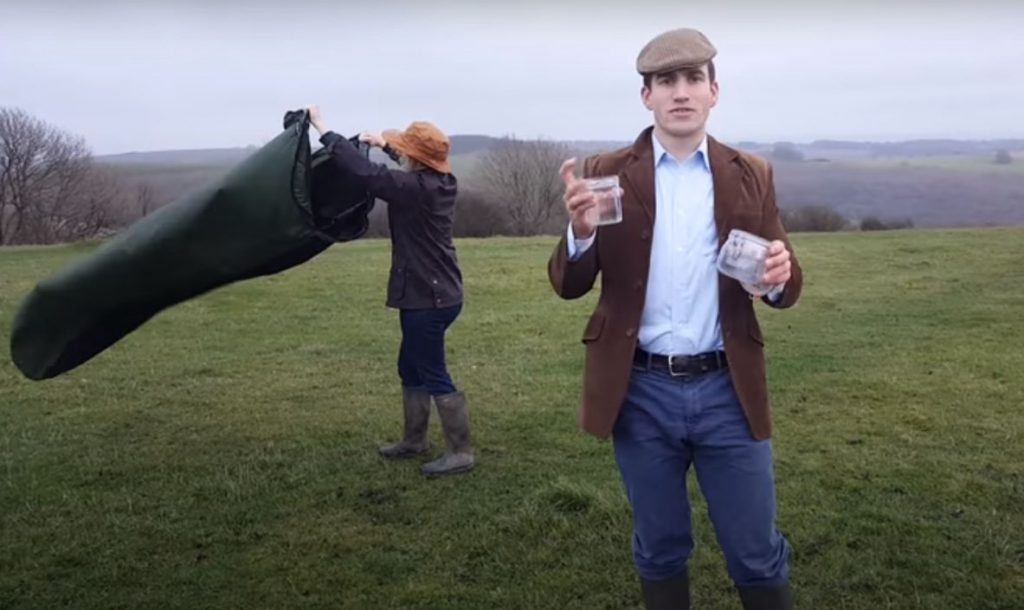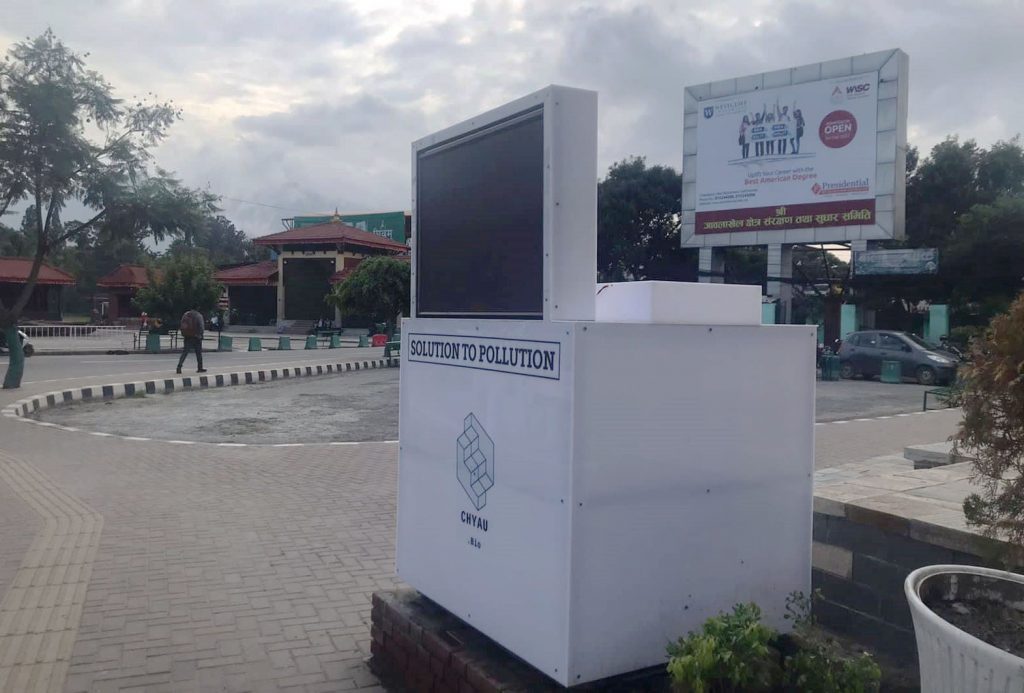Plants take in carbon dioxide and throw out oxygen. It is a lesson many read in their schools but forget. But, a group of engineers have remembered this basic lesson and now are gearing up to make an impact on Kathmandu’s air. This group of engineers are the brains behind Chyau Bio, an enterprise committed to solving Kathmandu’s air and waste problems, with algae.
“When we ask individuals if they want some waste, the answer is always that they don’t. So our solution to it is to let them give us that waste. In exchange, we will give them oxygen,” shares Gunjan Ghimire, a research engineer for Chyau Bio.
Expanding on the idea, Ghimire explains, “We cultured the algae we find in the environment, and we fed it with contaminated water. Here, the algae take in that; then, with enough sunlight, it produces oxygen that we can easily release in the environment or even bottle it.”
“The concept is of photosynthesis; there is nothing complicated about it,” he adds.

From algae to oxygen
Ghimire says Chyau Bio uses different types of algae, some natural and some mutated variations in the process. These variations of the algae have even recorded over 40 per cent of the oxygen in the controlled room environment for further projects.
“The easiest way to access carbon dioxide is the vehicles plying the roads. Our machines are collecting data and the recorded oxygen concentration (SpO2) stands at least over 22 per cent, more than the said oxygen’s natural presence in the air.”
Ghimire says the startup has machines that can make the oxygen extracting process easier, more efficient and more economic. “When we filter air off the 40-per cent environment, it increases the oxygen quality as well as decreases the resources needed to bottle the oxygen for medical usage.”
According to Riwaj Subedi, the admin and procurement head for Chyau Bio, the machine can be placed anywhere and scaled up or down as per the need while the machine releases oxygen into the air naturally, with the option to bottle them using a controller that they designed and put together from scratch at Fab Lab in Lalitpur.
“At the first trial, I held inside my room and that marked the start of Chyau Bio,” says Ghimire.

For demo purposes, the team has scaled down and prepared a portable model to convey their idea of how their brainchild is the solution to key problems of Kathmandu, including waste, wastewater, sewerage, smoke and smog as well as the low air quality. “That too is capable of giving an output of oxygen with 22 per cent SpO2, so it is a promising feat.”
Recently, Chyau Bio set up two machines in June this year with a capacity of 1,000 litres each.
In this, the Lalitpur metropolitan city, the Bagmati province government and the National Planning Commission have been extremely helpful, the founders add. “The Bagmati provincial has helped us financially by buying the two machines worth Rs 500,000 each. We will submit a two-year report to the provincial government,” informs Ghimire.
Ghimire adds, “One (of the two machines) can supply not just the contaminated water or air, but also wastewater and (black) smoke right from the resources. We have experimented with the wastewater and smoke from the incinerator after burning the plastics. We have gained similar results. The idea is to feed the algae carbon dioxide (CO2), then it turns into oxygen.”
Fear for the future
It was in the Lorax, a Pixar movie, where the antagonist of the movie creates a facade and then bottles air (or oxygen) for the people of the town, something that is available for free. In reality, a man in China has already achieved this feat.

Nepal too has already reached a point where people are selling and buying water in bottles that were previously available for free some decades ago.
In this context, the Chyau Bio team says it fears the future shown in Lorax and feels the need for action today to avoid paying for the air to breathe. With Chyau Bio, the young entrepreneurs with diverse backgrounds started looking for a way out and have come up with sustainable solutions.
“We are not looking forward to or claiming that our product is the replacement for trees. We do not believe in or preach that. But, in places where tree plantation has become difficult like in major cities such as Kathmandu, the machine can be an alternative for natural oxygen,” adds Ghimire.
Subedi adds, “We have realised that we need to work for the future today. And we are capable of finding solutions to any technical problem. But, even with the intentions, it is rather difficult for us to overcome the bureaucracy.”
It took the Chyau Bio team two months to set up the two machines for the Bagmati provincial government but eight months to visit the government offices and convince the authorities of their ideas and why it is important. Lack of policies and understanding also made the journey bumpy.
“Also, since we are young, we have been subjected to scepticism as were quite young. Convincing people regarding the capabilities of young Nepali entrepreneurs is another social challenge that runs parallel,” adds Subedi.
Big plans
As of today, Chyau Bio is yet to get enough real-time data to prove its hypothesis. However, the group says it has enough controlled room data to speculate that the startup can produce enough oxygen to balance the level in the environment and better the air quality in Kathmandu.

They further claim, “With our system and use of waste produced by Kathmandu, we can produce 64,000 tonnes of oxygen, the amount Nepal imported before Covid and during the oxygen crisis the pandemic created.”
Chyau Bio says it would prefer intercepting the sources to treat the wastewater and for that, it requires investment at all levels. “Imagine a structure built parallel to the open sewage system that today mixes into the rivers. In that, the sewerage gets filtered and treated with algae inside it, giving out treated water and oxygen from the outlets as well as filtered waste that would otherwise get mixed in the water today. Each structure will approximately cost Rs 1.5 million as per today’s market.”
The founders add they imagine a similar structure at every open sewage point to revert the beauty of the Kathmandu rivers. “It will take at least 18 months for us to see any visible result, but when in action, we can surely see the face of the rivers changing.”
As the time is longer, they are also in favour of integrating their technology into the already functioning wastewater treatment plants in the city. “However, since the treatment plant diverts the wastewater and then treats it, it does not align with our idea to decentralise. So we would want to set up a system there but do not want to be set there alone.”
Apart from that, they say Chyau Bio’s machines are portable and can be the solution to pollution in the Himalayan regions. “We spend a lot in transporting the waste and then in waste management here. But, we can just burn the waste there, in our machines, and get oxygen as a by-product.“
Chyau Bio also has plans to intercept the smokes coming out of brick kilns and cement factories although it needs to work on standards and policies for smooth operation. “If we can, we would like to work from the level of exhaust pipes coming out of the vehicles. Nonetheless, we might reach there one day too,” hopes Ghimire.
The post Chyau Bio: This startup is using school lessons to solve waste and air problems in Kathmandu appeared first on OnlineKhabar English News.
Comments
Post a Comment